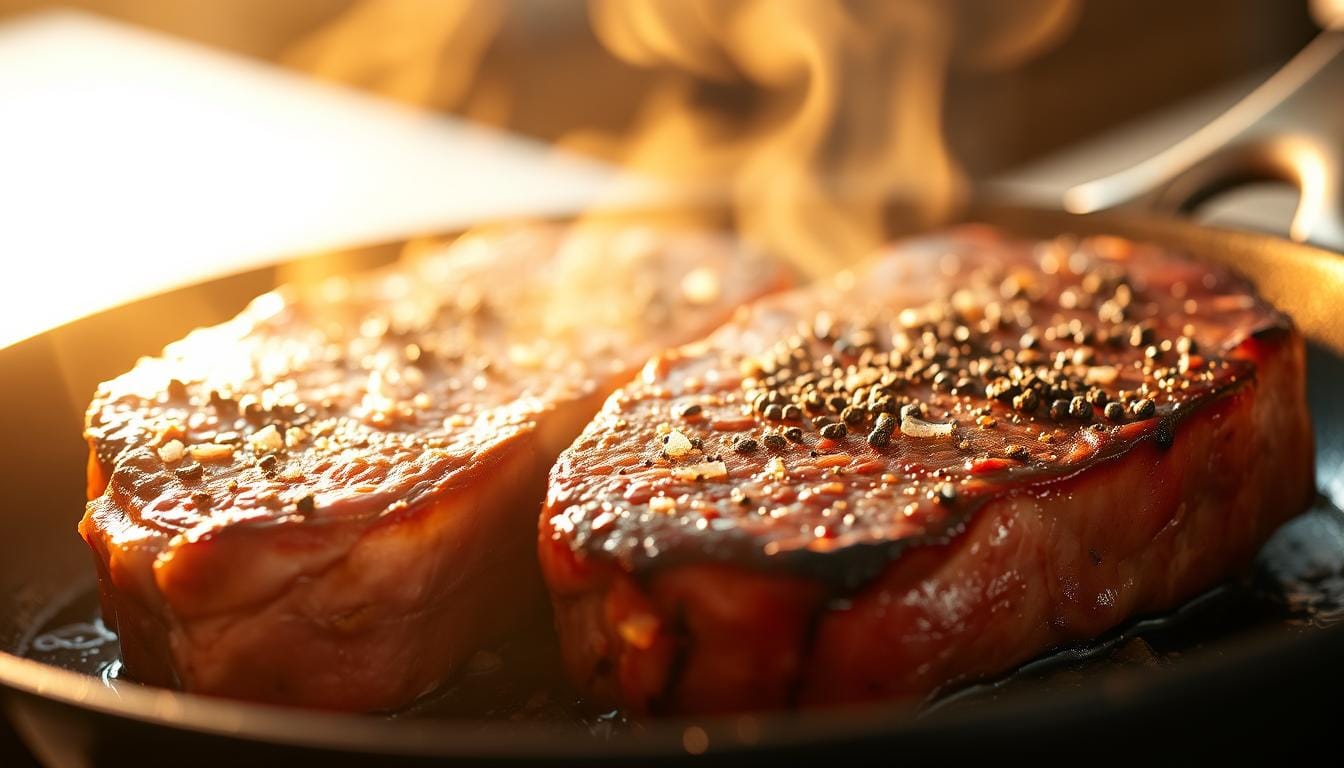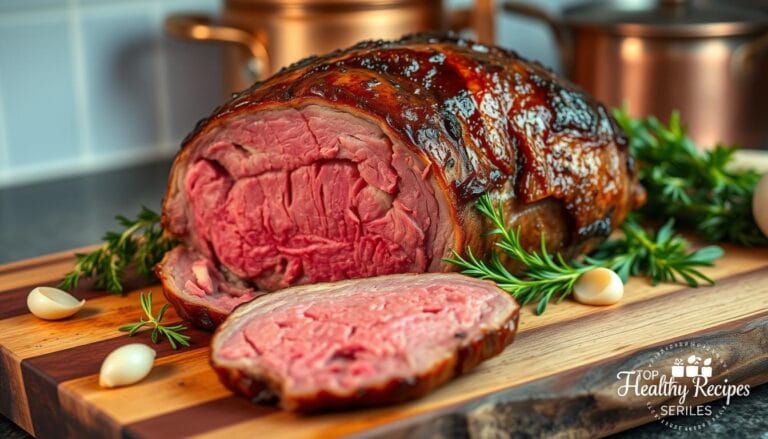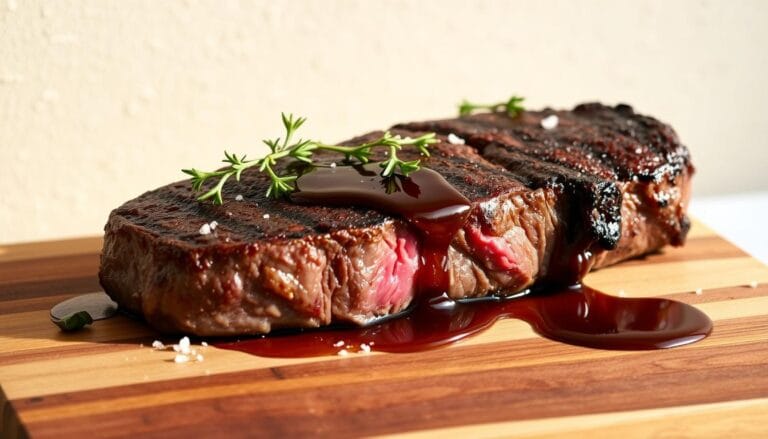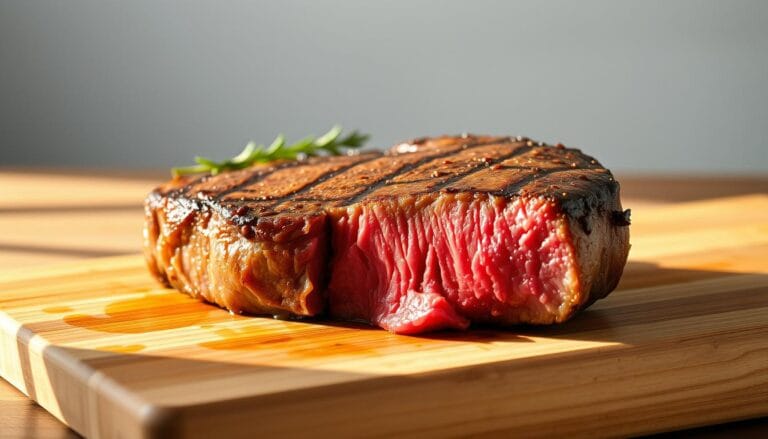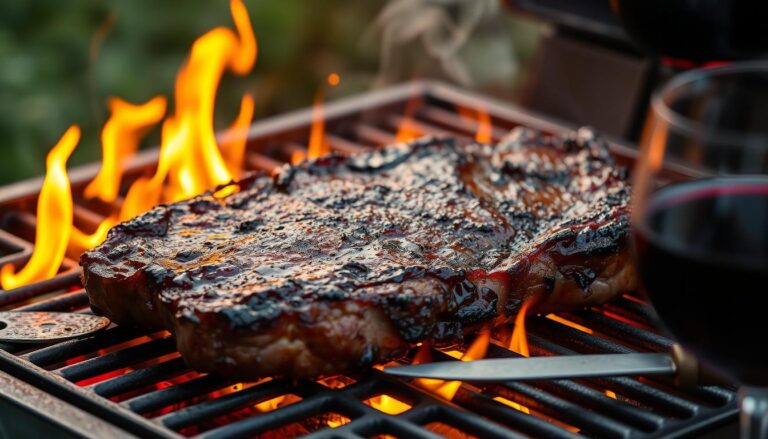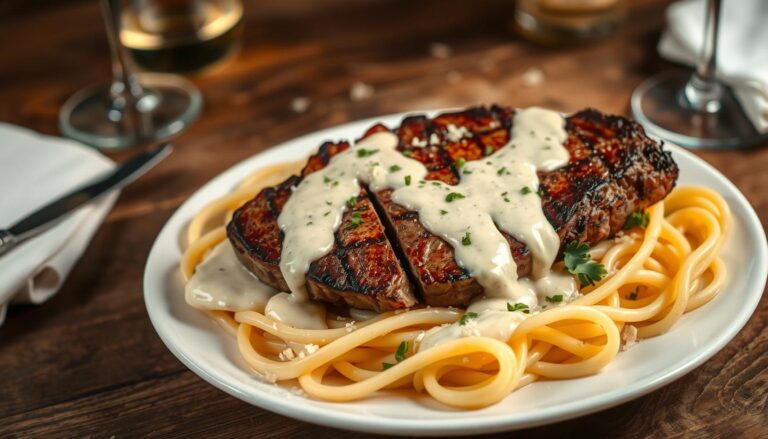Cooking Beef Rump Made Easy – Tasty Tips for Juicy, Flavorful Results
Table of Contents
Cooking Beef Rump Made Easy – Tasty Tips for Juicy, Flavorful Results
Want to improve your cooking skills with a tender and tasty meat? Rump steaks are a great pick. They taste amazing and are affordable if cooked right.
Learning to cook beef rump might seem hard, but it’s doable. With the right methods, you’ll get tender, juicy results every time. This guide will show you how to pick the best cut and serve it perfectly, making you a kitchen pro.
Key Takeaways
- Selecting the right rump steak for optimal flavor and tenderness.
- Preparation techniques to enhance the natural flavors of the meat.
- Effective cooking methods to achieve juicy results.
- Serving suggestions to complement your perfectly cooked beef rump.
- Tips for storing and reheating leftovers to maintain quality.
What Is Beef Rump?
Beef rump comes from the rear of the animal. It’s known for its rich flavor and tender texture. This makes it a great choice for many cooking methods.
To get to know beef rump, you need to know about beef cuts. Beef is divided into eight primal cuts, with the rump in the round primal cut. The round is split further, and the rump is a sub-primal cut. It’s lean and has a strong flavor.
Understanding Cuts of Beef
Beef rump is similar to sirloin and round cuts. It’s lean but juicy when cooked right. You can get it as steaks or roasts, making it versatile for recipes.
Here’s a quick comparison of beef rump with other cuts:
| Cut | Leaness | Tenderness | Flavor |
|---|---|---|---|
| Beef Rump | Lean | Tender when cooked properly | Rich, beefy |
| Sirloin | Moderate | Tender | Rich, slightly sweet |
| Round | Lean | Can be tough if overcooked | Mild, beefy |
Nutritional Value of Beef Rump
Beef rump is not just tasty but also nutritious. It’s packed with protein for muscle repair and growth. It also has iron, zinc, and B vitamins for health.
A 3-ounce serving of cooked beef rump has:
| Nutrient | Amount |
|---|---|
| Protein | 22 grams |
| Fat | 6 grams |
| Iron | 3 mg |
| Zinc | 4 mg |
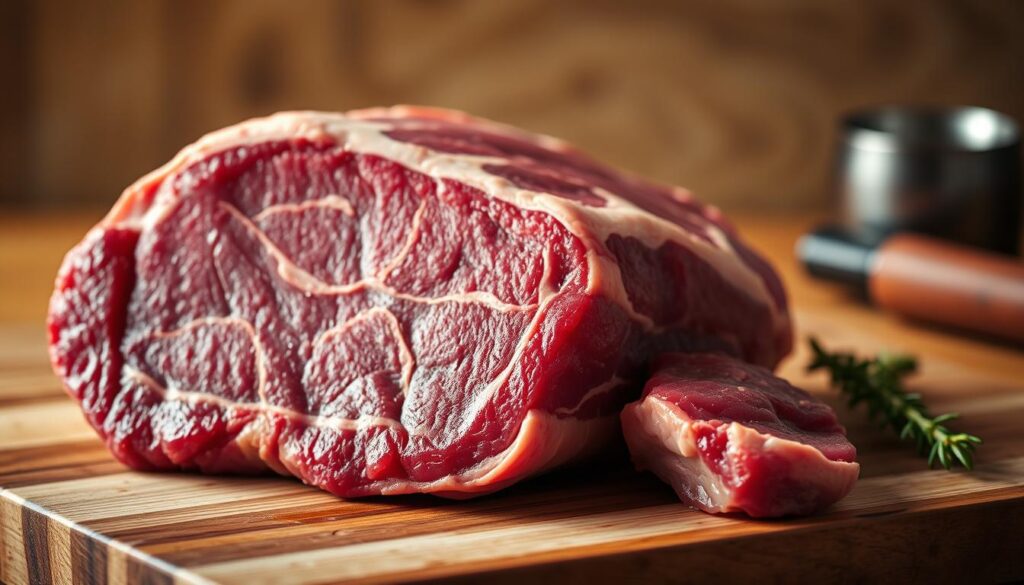
Knowing the nutritional value and characteristics of beef rump helps in cooking. It’s great for grilling, roasting, or slow-cooking. Beef rump is a versatile cut for many delicious dishes.
Why Choose Beef Rump?
Beef rump is a flavorful and affordable cut of meat. It has qualities that make it stand out from other beef cuts.
Flavor Profile
Beef rump has a robust flavor profile that gets even better when cooked. Its location on the animal adds to its tenderness and taste. When cooked right, it’s juicy and full of flavor, making it a pleasure to eat.
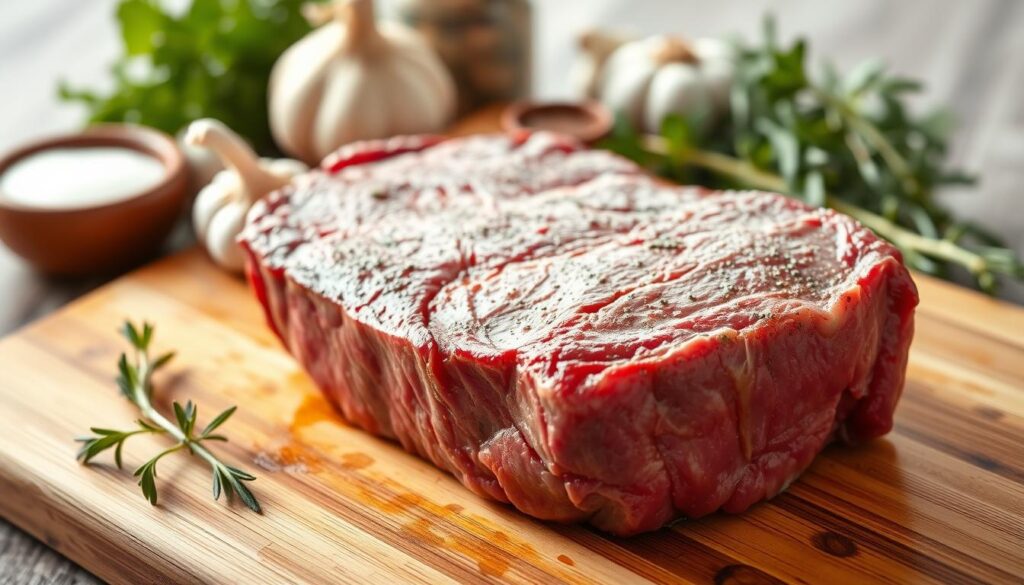
Cost-Effectiveness
Beef rump is also cost-effective. It’s cheaper than cuts like ribeye or tenderloin but doesn’t lack in taste. This makes it perfect for those who want to cook tasty meals without spending a lot.
| Beef Cut | Average Price per Pound | Flavor Profile |
|---|---|---|
| Beef Rump | $8-$12 | Robust, Tender |
| Ribeye | $15-$20 | Rich, Marbled |
| Tenderloin | $20-$25 | Lean, Tender |
Versatility in Cooking
Beef rump is great for many cooking methods. You can grill, roast, or slow-cook it. It’s perfect for quick dinners or special meals, as it can be cooked in many ways.
- Grilling: Achieves a nice char on the outside while keeping the inside tender.
- Roasting: Brings out the rich flavors of the beef.
- Slow Cooking: Results in tender, fall-apart texture.
Adding beef rump to your meal plans means you get a delicious, satisfying meal. It’s both affordable and versatile.
Preparing Your Beef Rump
A well-prepared beef rump is the key to a delicious meal. You need to pick the right cut, have the right tools, and know how to marinate for flavor.
Selecting the Right Cut
Choose a beef rump that’s bright red and has lots of marbling. Marbling is the white fat that makes the meat tender and tasty. Also, pick a cut that’s thick enough for even cooking.
Key characteristics to look for:
- Bright red color
- Good marbling
- Appropriate thickness
Essential Tools for Preparation
The right tools are important for preparing your beef rump. You’ll need a sharp knife, a cutting board, and a meat tenderizer. These tools help trim fat, prepare the meat, and make it tender.
| Tool | Purpose |
|---|---|
| Sharp Knife | Trimming excess fat |
| Cutting Board | Preparing the meat |
| Meat Tenderizer | Enhancing tenderness |
Marinating for Flavor
Marinating your beef rump can really boost its taste. A good marinade has acid, oil, and spices. The acid breaks down proteins, making the meat tender.
Tips for marinating:
- Use a mixture of acid, oil, and spices
- Marinate for at least 2 hours or overnight
- Keep the meat refrigerated during marinating
Cooking Methods for Beef Rump
To get the most out of beef rump, knowing how to cook it is key. Each method brings out different flavors and textures. This makes beef rump very versatile.
Roasting Techniques
Roasting is a favorite way to cook beef rump. It ensures even cooking and results in a tender, flavorful roast. First, preheat your oven to 325°F (165°C). Season the beef with your favorite herbs and spices, then put it in a roasting pan.
For medium-rare, cook for about 15 minutes per pound. Or until the internal temperature hits 130°F to 135°F (54°C to 57°C).
Tips for Roasting:
- Use a meat thermometer for accurate internal temperatures.
- Let the beef rest for 10 to 15 minutes before slicing.
- For a crispy crust, sear the beef in a hot pan before roasting.
Grilling Tips
Grilling beef rump adds a smoky flavor and a nice char. To grill, preheat your grill to medium-high heat. Season the beef as you like, then grill for about 4 to 5 minutes per side for medium-rare.
Grilling Tips:
- Use indirect heat to prevent burning.
- Let the beef rest after grilling to allow juices to redistribute.
- For grill marks, rotate the beef 90 degrees after 2 minutes on each side.
Slow Cooking for Tenderness
Slow cooking is great for tenderizing tougher cuts of beef rump. Cooking the beef at a low temperature for a long time makes it tender and fall-apart.
| Cooking Method | Temperature | Cooking Time |
|---|---|---|
| Slow Cooking | 275°F (135°C) | 8-10 hours |
| Roasting | 325°F (165°C) | 2-3 hours |
| Grilling | Medium-High Heat | 8-10 minutes |
As Chef Gordon Ramsay once said, “The key to a perfect roast is not just the cooking, but also the resting.” This is true for all cooking methods. It shows how important it is to let the beef rest before serving.
Seasoning Your Beef Rump
The right seasoning can take your beef rump to new heights. Seasoning does more than add flavor; it brings out the meat’s natural taste. Whether you’re roasting, grilling, or slow-cooking, the right seasonings make a big difference.
Recommended Spices and Herbs
For seasoning beef rump, some spices and herbs are top choices. Here are a few:
- Garlic powder: Adds a savory depth without the pungency of fresh garlic.
- Rosemary: Pairs well with beef, perfect for roasting or grilling.
- Thyme: Enhances the rich flavor of beef rump.
- Paprika: Adds a smoky sweetness, great for grilling.
- Black pepper: Boosts the flavor and adds a nice kick.
You can use these herbs and spices alone or together. This lets you create a flavor that matches your taste.
Creating a Flavorful Rub
A dry rub can give your beef rump a crust, keeping juices and flavors in. To make a simple rub, mix:
- 2 tablespoons brown sugar
- 1 tablespoon smoked paprika
- 1 tablespoon garlic powder
- 1 tablespoon salt
- 1 teaspoon black pepper
- 1 teaspoon dried thyme
Spread this mixture all over your beef rump, making sure it’s evenly coated. Let it sit for at least an hour before cooking. This lets the flavors soak into the meat.
Marinades to Try
Marinades are also great for adding flavor to your beef rump. Here are a few recipes to try:
- Olive Oil and Herb Marinade: Mix olive oil, minced garlic, chopped rosemary, and thyme. It’s perfect for grilling or roasting.
- Asian-Inspired Marinade: Combine soy sauce, honey, grated ginger, and garlic for a sweet and savory flavor.
- Spicy Marinade: Blend chili flakes, lime juice, and olive oil for a spicy kick.
Put your beef rump in a marinade for at least 2 hours or overnight. The acid in the marinade tenderizes the meat. The herbs and spices add flavor.
Cooking Times and Temperatures
To cook a beef rump that’s juicy and flavorful, you need to get the cooking time and temperature right. You must understand the role of a meat thermometer. Also, know the recommended internal temperatures for your desired doneness. Adjust cooking times based on the meat’s thickness and the cooking method.
Using a Meat Thermometer
A meat thermometer is key to ensuring your beef rump is cooked safely. There are many types, like digital thermometers and oven-safe probes. To use it right, insert the probe into the thickest part of the beef rump, avoiding fat or bone. For digital thermometers, wait for the temperature to stabilize before reading it.
Recommended Internal Temperatures
The internal temperature of your beef rump is key to its doneness. Here are the recommended temperatures:
- Rare: 130°F – 135°F
- Medium-Rare: 135°F – 140°F
- Medium: 140°F – 145°F
- Medium-Well: 145°F – 150°F
- Well-Done: 150°F – 155°F
Using a meat thermometer ensures your beef rump reaches a safe minimum internal temperature. This is important for food safety.
Adjusting Cooking Time
Cooking time for beef rump depends on its thickness, starting temperature, and cooking method. A general rule is to cook it for 15-20 minutes per pound in a preheated oven at 325°F. But, this can vary. It’s best to use a meat thermometer to check for doneness, not just cooking time.
Factors like oven hot spots or uneven grill temperatures can affect cooking consistency. So, you might need to make adjustments.
Letting It Rest
The secret to a juicy and flavorful beef rump is in the resting. After cooking, it’s tempting to slice it right away. But, resting the meat is a key step you shouldn’t skip.
Importance of Resting Meat
Resting meat makes it more tender and juicy. When you cook, the fibers contract and juices move to the surface. Letting it rest allows these juices to spread evenly, making each bite flavorful and moist.
The science behind resting meat is simple. It’s about relaxing meat fibers and spreading juices evenly. This step can turn your cooking beef rump from good to great.
How to Rest Beef Rump Properly
To rest your beef rump right, first remove it from heat. Then, place it on a wire rack or plate, covering it loosely with foil. This keeps it warm without trapping too much moisture. The resting time depends on the meat’s size; rest it for 10-15 minutes per pound.
- For smaller cuts (less than 2 pounds), a resting period of 10-15 minutes is usually sufficient.
- For larger cuts (2 pounds or more), you may need to rest the beef rump for 20-30 minutes or more.
Keep the resting beef rump warm and draft-free. Use the oven (turned off) or a warm kitchen corner. Avoid cold places, as they can cool the meat too fast.
Timing the rest with your side dishes can make cooking easier. By the time your sides are ready, your beef rump will be perfectly cooked and rested, ready to serve.
Serving Suggestions
It’s time to serve your delicious beef rump. Serving it right is an art. You need to match its rich flavor with the right sides, sauces, and how you present it.
Side Dishes for Beef Rump
Choosing the right sides can make your beef rump even better. Try roasted potatoes or garlic mashed potatoes for a cozy meal. For something lighter, a green salad or roasted vegetable medley can balance out the savory beef.
- Roasted carrots and parsnips
- Grilled asparagus with lemon
- Sautéed spinach with garlic
Sauces and Condiments
The right sauce can really bring out the flavor of your beef rump. Go for a red wine reduction or a zesty chimichurri. For a bit of heat, a horseradish cream is perfect.
- Red wine reduction for a rich, bold flavor
- Chimichurri for a fresh, herby taste
- Horseradish cream for a spicy kick
Plating Techniques
How you present your beef rump matters. For a family-style meal, slice the beef and arrange it on a platter with your sides. For individual servings, use a more formal plating with a portion of beef and sides.
To make it look professional, keep the temperature of your plate right. Make sure everything looks good together. A well-presented plate is not just tasty but also beautiful to look at.
Storing Leftovers
Proper storage of leftover beef rump is key to keeping it fresh and safe. After cooking a tasty beef rump, you might have leftovers. Storing them right lets you enjoy your meal again, keeping the taste and safety intact.
Proper Refrigeration
To store leftover beef rump in the fridge, cool it down to room temperature within two hours of cooking. This step is vital to stop bacteria from growing. Once it’s cooled, put it in an airtight container or wrap it tightly in plastic or foil. It can stay in the fridge for 3 to 4 days. Don’t forget to mark the container with the cooking date.
Best Practices for Freezing
Freezing is great for longer storage. Wrap the beef rump tightly in freezer-safe wrap or put it in an airtight container. Freezer bags work well too, just make sure to remove air before sealing. Write the date and what’s inside on the package. Frozen beef rump can last for up to 3 months. To thaw, leave it in the fridge overnight or thaw it quickly in cold water.
When reheating, make sure the beef rump heats up to at least 165°F (74°C). This ensures it’s safe to eat. Proper storage and reheating mean you can enjoy your beef rump for many meals.
Common Mistakes to Avoid
To cook a perfect beef rump, avoid common mistakes. Cooking beef rump can be rewarding but mistakes can ruin it. It’s important to know what to avoid.
Overcooking Your Beef
One big mistake is overcooking the beef rump. It can become dry and tough from too much heat. To avoid this, watch the cooking temperature and time closely.
Use a meat thermometer to check the doneness. It’s better to slightly undercook it. The meat will cook a bit more when it rests.
Tip: Check the internal temperature. Remove the beef when it reaches your desired doneness. For medium-rare, aim for 130°F to 135°F (54°C to 57°C).
Underseasoning Your Rump
Another mistake is not seasoning the beef rump enough. Seasoning brings out the meat’s natural flavors. It’s not just salt and pepper; it’s about finding the right balance of flavors.
Season the meat well before and during cooking. Try different herbs and spices to find what you like best.
“The way you cook and season your beef can make all the difference in the world. A good seasoning can elevate the dish, while underseasoning can leave it tasting bland.”
Skipping the Resting Period
Not letting the beef rest is another mistake. Resting allows juices to redistribute, making the meat tender and flavorful. Cutting into the meat too soon can make it dry.
Resting Tip: Tent the beef with foil to keep it warm. This helps retain heat and juices.
Pairing Drinks with Beef Rump
Finding the right drink to go with beef rump is key. Whether you love wine, beer, or prefer something without alcohol, there’s a perfect match for you. It can make your meal even better.
Best Wine Choices
For wine lovers, full-bodied reds are top picks. Cabernet Sauvignon and Malbec are favorites. They have strong tannins that match the beef’s richness.
| Wine Type | Price Range | Why It Pairs Well |
|---|---|---|
| Cabernet Sauvignon | $15-$50 | Robust tannins complement the beef’s richness |
| Malbec | $10-$30 | Fruity flavors enhance the beef’s tenderness |
Beer Pairings
Beer fans might enjoy stouts and IPAs with beef rump. These beers have a bitterness that balances the meat’s richness.
- Stouts: Robust, roasted flavors complement the beef’s char
- IPAs: Hoppy bitterness balances the richness of the beef
Non-Alcoholic Options
Prefer not to drink alcohol? No worries. Craft sodas, specialty teas, and mocktails are great alternatives. They can all pair well with beef rump.
- Craft Sodas: Unique flavors like ginger ale can add a refreshing contrast
- Specialty Teas: Herbal teas like peppermint can cleanse the palate
- Mocktails: Virgin Marylands or virgin mojitos can add a festive touch
Beef Rump in Different Cuisines
Exploring beef rump recipes shows a rich mix of culinary traditions. From classic American dishes to international flavors, it’s all there.
Beef rump is a cut that shines in many cuisines. In America, it’s the main attraction in pot roasts and steaks. These are often served with compound butter, highlighting regional tastes and cooking methods.
American Recipes
American beef rump recipes vary a lot. You’ll find slow-cooked pot roasts and grilled steaks. Pot roast is a beloved comfort food, cooked with veggies like carrots and potatoes. Grilled beef rump steak, seasoned with herbs and spices, is also popular. It’s often served with garlic mashed potatoes.
International Dishes
Beef rump is celebrated worldwide in different ways. In Argentina, it’s a key part of asado, a traditional barbecue. Korean cuisine has bulgogi, where thinly sliced beef rump is marinated and grilled. Italian cuisine offers tagliata, a grilled beef rump served sliced, often with arugula and parmesan cheese.
Fusion Ideas
Fusion cuisine brings new twists to beef rump. For example, beef rump tacos with kimchi slaw mix Korean kimchi with Mexican tacos. Another idea is a Mediterranean-American dish. Here, grilled beef rump is paired with a Greek salad and tzatziki sauce. This combines Mediterranean freshness with American grilling.
These examples show how versatile beef rump is in different cuisines. They offer a wide range of flavors and cooking techniques to try.
Creative Leftover Ideas
Turn your leftover beef rump into tasty new dishes. A bit of creativity can change last night’s dinner into tomorrow’s meal. Here are some ideas to start with.
Sandwiches
Beef rump is great in sandwiches. Slice it thinly against the grain and place it on a crusty baguette. Add your favorite toppings. For a zing, try horseradish sauce or caramelized onions for sweetness.
For a hot sandwich, melt cheese on top and grill until it’s golden. Check out tophealtyrecipes.com for more steak pairing ideas.
Stir-Fry
A beef rump stir-fry is quick and tasty. Slice the beef into thin strips and stir-fry with your favorite veggies. Use soy or oyster sauce for an Asian twist.
Serve it over rice or noodles for a hearty meal. The secret to a great stir-fry is quick cooking over high heat. Have all your ingredients ready before starting.
Tacos
Beef rump tacos are a tasty surprise. Shred or chop the beef and season it with taco spices. Top it with salsa, avocado, sour cream, and cheese.
Add fresh cilantro for extra flavor. Consider sautéed onions or bell peppers for more taste.
These ideas will help you enjoy your beef rump in new ways. Whether you make sandwiches, a stir-fry, or tacos, you’ll love the flavors.
FAQs About Cooking Beef Rump
Learning how to cook a beef rump can make your meals better. It doesn’t matter if you’re new to cooking or have lots of experience. Knowing the basics of cooking this cut can make your food taste amazing.
How Do I Know When It’s Done?
There are a few ways to check if your beef rump is cooked right. You can look at the color, feel its tenderness, or use a meat thermometer. For medium-well, the meat should be around 150°F to 155°F (65°C to 68°C) inside.
Jacques Pépin said, “The key to cooking meat is to understand its structure and to cook it in a way that makes it tender and flavorful.”
“Cooking is not just about sustenance, it’s about the joy of creating something that brings people together.”
Can I Cook Beef Rump Without a Grill?
Yes, you can cook beef rump without a grill. You can use the oven for broiling or the stovetop for pan-searing. Slow cooking in a crockpot or Dutch oven also works well.
What Is the Best Way to Reheat Leftovers?
Reheating beef rump leftovers needs care to keep it tender and tasty. The best way is to use a low-temperature oven. Wrap the beef in foil and heat it at 250°F (120°C) until it’s warm. You can also use a microwave with a microwave-safe dish and cover it to keep moisture in.
- Slice the beef thinly against the grain before reheating for more even heating.
- Use a meat thermometer to ensure the beef reaches a safe internal temperature.
- Add a bit of broth or sauce to the beef while reheating to keep it moist.
By following these tips, you can enjoy your beef rump leftovers without losing much quality.
Resources for Further Learning
Whether you’re new to cooking or have lots of experience, the right resources can help a lot. As you explore beef rump, having the right tools is key.
Cookbooks for Beef Enthuasiasts
Cookbooks are great for learning the old-fashioned way. Here are some top picks for beef recipes:
- “The Joy of Cooking” by Irma S. Rombauer, a classic with lots of cooking tips.
- “Mastering the Art of French Cooking” by Julia Child, filled with amazing beef recipes.
- “Meat: A Kitchen Education” by Steven Raichlen, all about different meats, including beef.
These books are full of info on making tasty beef rump dishes. They cover everything from basic to advanced recipes.
Online Cooking Classes
Online cooking classes are super popular today. They’re flexible and cover many topics. Here are some great ones:
- Courses on Masterclass, taught by famous chefs like Gordon Ramsay.
- America’s Test Kitchen Online Cooking School, with detailed lessons on cooking techniques.
- YouTube channels like Binging with Babish, for creative recipe ideas.
These platforms offer video lessons. They make it easy to follow along and learn new cooking skills.
Recommended Cooking Blogs
Cooking blogs are also a great resource. They offer new recipes and cooking tips. Here are some top blogs for beef rump:
- The Kitchn, known for its detailed cooking guides and recipes.
- Serious Eats, with deep cooking techniques and restaurant reviews.
- Food52, a community site with lots of recipes and cooking advice.
These blogs are always updated with new content. They keep you in the loop with the latest cooking trends and techniques.
By using these resources, you’ll get better at cooking delicious beef rump dishes. As
“The discovery of a new dish does more for human happiness than the discovery of a new star.”
– Jean Anthelme Brillat-Savarin.
Conclusion
Learning to cook beef rump can boost your cooking skills and give you a tasty meal. This article has shown you how to make delicious rump steaks. These will surely impress your family and friends.
Key Takeaways
To cook beef rump well, control the temperature and let it rest long enough. Also, use the right amount of seasoning. These steps work for all cooking methods, making your dish tender and tasty.
Experimenting with New Recipes
Once you’re good at cooking beef rump, try new recipes and ingredients. Cooking is both a science and an art. You can change things to fit your taste. Experiment with marinades, seasonings, and cooking methods to find your favorite rump steak.
With time and effort, you’ll get better at cooking beef rump. This cut is versatile, flavorful, and affordable. It’s a great choice for home cooks. Start exploring and find your new favorite dishes.
FAQ
How do I cook a rump steak medium well?
What is the best way to cook beef rump?
How do I make rump steak tender?
Can I cook rump steak without a grill?
What are some rump steak recipes?
How do I reheat leftover beef rump?
Can I freeze cooked beef rump?
For more cooking tips, stay connected with us. We also recommend the cookbook Skinnytaste Simple: Easy, Healthy Recipes with 7 Ingredients or Fewer
For more Recipes about Steak ?
Did You try our recipe ?
There are no reviews yet. Be the first one to write one.
